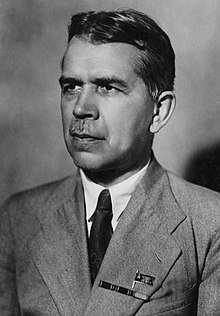Sergey Vavilov
Sergey Vavilov | |
|---|---|
Сергей Вавилов | |
 Vavilov in 1945 | |
| Born | Sergey Ivanovich Vavilov 24 March 1891 |
| Died | 25 January 1951 (aged 59) Moscow, Russian SFSR, Soviet Union |
| Nationality | Russian |
| Alma mater | Moscow State University |
| Known for | Vavilov-Cherenkov effect |
| Scientific career | |
| Fields | Physics, optics |
| Doctoral advisor | Pyotr Lebedev[1] |
| Doctoral students | Pavel Cherenkov[1] Ilya Frank Vladimir Veksler |
Sergey Ivanovich Vavilov (Russian: Серге́й Ива́нович Вави́лов [sʲɪrˈɡʲej ɪˈvanəvʲɪtɕ vɐˈvʲiləf]; 24 March [O.S. 12 March] 1891 – January 25, 1951) was a Soviet physicist, the President of the Academy of Sciences of the Soviet Union from July 1945 until his death. His elder brother Nikolai Vavilov was a famous Russian geneticist.
Biography
[edit]Vavilov founded the Soviet school of physical optics, known by his works in luminescence. In 1934 he co-discovered the Vavilov-Cherenkov effect, a discovery for which Pavel Cherenkov was awarded a Nobel Prize in Physics in 1958. The Kasha–Vavilov rule of luminescence quantum yields is also named for him.
He was a member of the USSR Academy of Sciences from 1932, Head of the Lebedev Institute of Physics (since 1934), a chief editor of the Great Soviet Encyclopedia, a member of the Supreme Soviet from 1946 and a recipient of four Stalin Prizes (1943, 1946, 1951, 1952).
He wrote on the lives and works of great thinkers, such as Lucretius, Galileo Galilei, Isaac Newton, Mikhail Lomonosov, Michael Faraday, and Pyotr Lebedev, among others.
At the end of 1950, Vavilov's health who was suffering from heart and lung diseases deteriorated significantly. In December-January he was treated at the Barvikha Sanatorium. Returning from the sanatorium on January 12, 1951, he chaired an expanded meeting of the Presidium of the Academy of Sciences. On January 25, 1951, at 4:45 a.m., he died of a myocardial infarction.
Legacy
[edit]A meteorological station (as well as a glacier and an ice cap) in October Revolution Island, in the Severnaya Zemlya group have been named after Vavilov. A minor planet 2862 Vavilov discovered in 1977 by Soviet astronomer Nikolai Chernykh is named after him and his brother Nikolai Vavilov.[2] The crater Vavilov on the far side of the Moon is also named after him and his brother.
There is a ship named after him, the Akademik Sergey Vavilov. She is a research vessel that can carry approximately 150 crew and passengers, and is a Class-1A icebreaker which regularly makes trips to Antarctica and the Arctic. In the summer of 2010 she was working in and around the coast of Svalbard. Also, an Aeroflot plane, with VO-BHL identification number is named after him.
References
[edit]- ^ a b "Sergey Ivanovich Vavilov". Physics Tree.
- ^ Schmadel, Lutz D. (2003). Dictionary of Minor Planet Names (5th ed.). New York: Springer Verlag. p. 235. ISBN 3-540-00238-3.
- М. Борисов, "Изследванията на С. И. Вавилов върху физиката на луминесцентните явления", Научно-популярна сесия в памет на акад. Сергей Иванович Вавилов (17 – 18.10.1951), София, Изд. БАН, с. 39–77 (1954)
- Н. Ахабабян, Сергей Иванович Вавилов (по случай 100 години от рождението му), Светът на физиката, кн. 1, с. 30–35 (1991)
- Л. Спасов, Г. Камишева, Милко Борисов за себе си и другите за него, София, Акад. изд. "Проф. М. Дринов" (2008) с. 183
External links
[edit]- 1891 births
- 1951 deaths
- 20th-century Russian physicists
- Academic staff of Bauman Moscow State Technical University
- Foreign members of the Bulgarian Academy of Sciences
- Full Members of the USSR Academy of Sciences
- ITMO University
- Members of the German Academy of Sciences at Berlin
- Foreign members of the Serbian Academy of Sciences and Arts
- Academic staff of the Moscow Institute of Physics and Technology
- Moscow State University alumni
- Academic staff of Moscow State University
- Academic staff of Moscow Power Engineering Institute
- Presidents of the Russian Academy of Sciences
- Presidents of the USSR Academy of Sciences
- Second convocation members of the Supreme Soviet of the Soviet Union
- Third convocation members of the Supreme Soviet of the Soviet Union
- Recipients of the Stalin Prize
- Recipients of the Order of Lenin
- Recipients of the Order of the Red Banner of Labour
- Russian military personnel of World War I
- Soviet physicists
- Burials at Novodevichy Cemetery
- Proceedings of the USSR Academy of Sciences editors
- Russian scientists
- Deputies of Mossoviet
- Deputies of Lensovet
